Coney Island
Coney Island is one of the tourist sights in Brooklyn that I most enjoyed visiting in New York, which is why I think it deserves a separate entry.
Coney Island is a peninsula on the very edge of southern Brookyln, and forms a large beach on the shore of the Atlantic Ocean. As well as for its beach, Coney Island is also famous for its theme parks and circus.
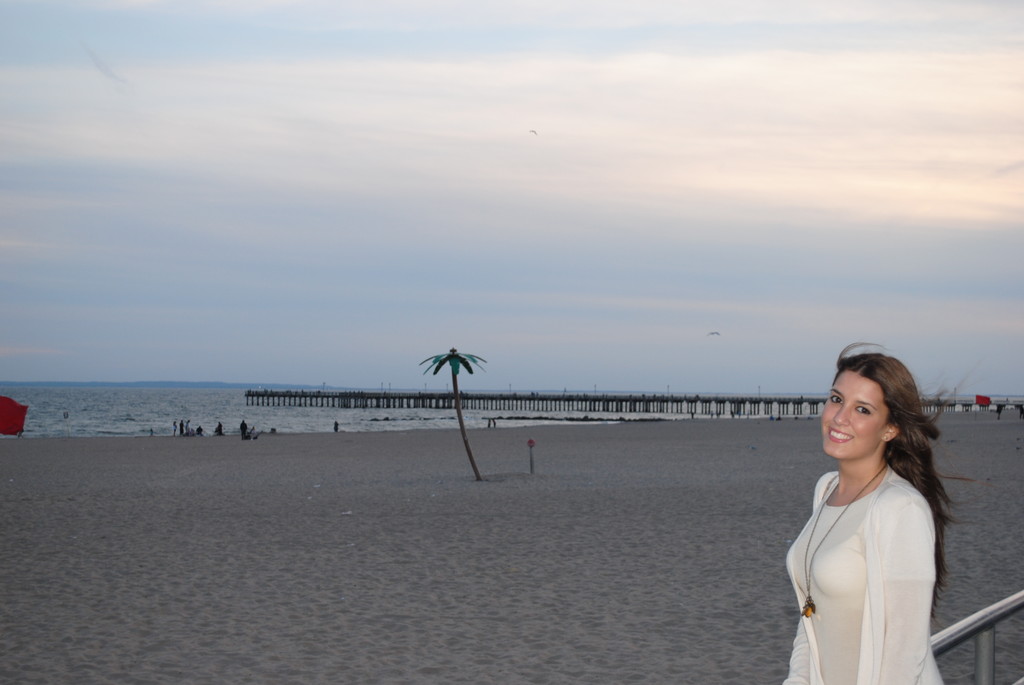
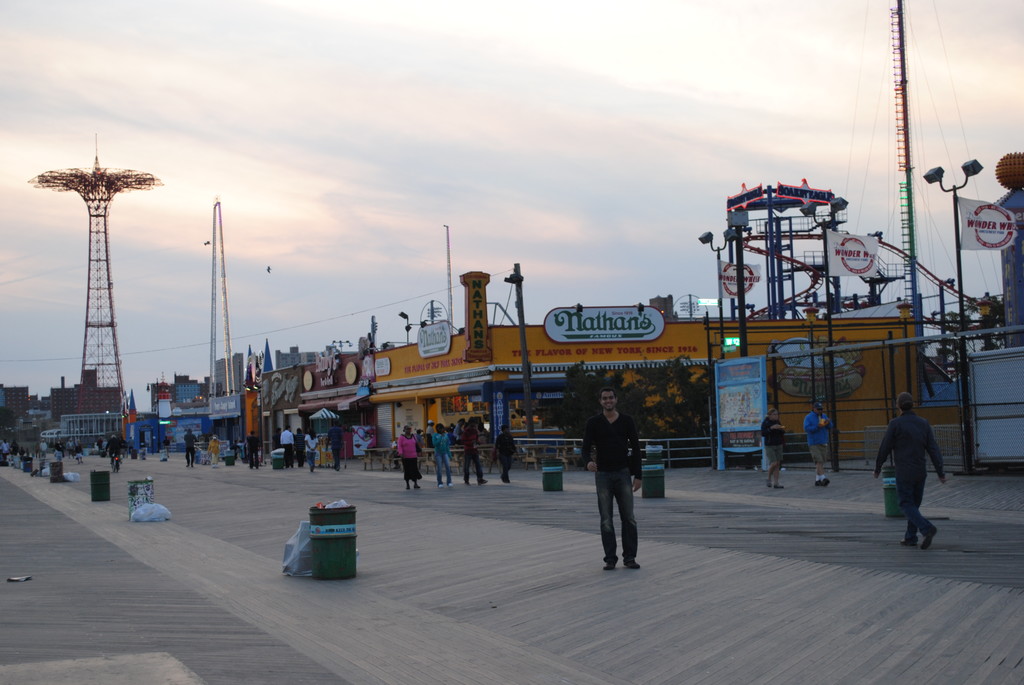
I changed to this part of the city from Manhattan because of its theme parks, since before I came to New York and was doing my research on what there was to see, I couldn't resist the idea when I found out there was a 1950s-style theme park relatively close to the Big Apple.

And the place exceeded my expectations: in addition to a rollercoaster, a ferris wheel and many other rides, they also had a slingshot ride. This is my all-time favourite, and it's been years since I went on it at the fair in Murcia. You can imagine my expression then when I saw they had a slingshot ride in New York, and the best thing is that it was ever better than what I had in mind.
The attraction consists of a ball with two seats inside it, which is supported by a large piece of elastic, and when the ride starts, the elastics shoot the ball upwards with you inside it (note that this isn't really suitable for people who don't like adrenaline-fueled rides! ). The slingshot on Coney Island is slower than the slingshot in Murcia, but what a surprise I got when up in the air I realised I had a magnificent view of Manhattan in the distance, with its skyscrapers and tiny-seeming bridges, and the Atlantic Ocean at my feet. It's one of my best memories.

In my opinion, if you're spending over three or four days in New York, it's well worth taking a break from Manhattan and its skyscrapers to come to southern Brooklyn. The best memory I have of my first visit to New York isn't of its skyscrapers, but of this place. It's really wonderful: the rides look colourful and exciting, and on the other hand, it's right next to the Atlantic Ocean; sunset on the wooden promenade on the shore is also a beautiful thing to witness.
It's nothing like what you first think of when you think of New York, and this is what I like about it - after a day rushing around in the city, the best way to end your day is by quietly watching the sunset with only the sound of the seagulls and the fairground rides in the background. It was a really special evening, relaxed and with a wonderful sky, and the first time I've been so close to the Atlantic Ocean.

I couldn't enjoy the beach properly since I visited in mid-September, and though it was hot, it wasn't warm enough for sunbathing, and I didn't fancy putting my bikini on and then getting the metro later...
If you get peckish while you're there, there are all kinds of different food stalls in the area, from the typical hot dogs and pretzels to kebabs, and even a local branch of the 'Popeyes' chain, where they sell very tasty KFC-style fried chicken.

In terms of price, there are two options for going on the rides: one is to pay for an all-day pass, which lets you go on all the rides all day long without paying anything extra, or you can pay for each ride separately. I don't remember exactly how much I paid per ride, or what a day pass cost (it was almost three years ago that I was there), but I remember working it all out later and it was actually better value to get a day pass - plus, if you've gone down there from Manhattan, you should take advantage of it and go on everything.

The best time of the day to go to the beach is in the morning, and for going on the rides, from midday to dusk, since in the evening, though the area is quite charming, it can also be quite dangerous, too. In terms of season, I can't recommend when's definitely better to go, but don't go in the wintertime or on rainy or cold days, since you won't enjoy the place if you're cold as it's outside. When it's raining, I don't think the rides will be open, and neither will you fancy going up in the air on the Ferris wheel.

If you're going to be in New York next March 28th, you might be interested in going to the 'Coney Island USA Spring Fundraising Gala', a festival which is taking place on Coney Island and where there'll be live music, a festival king and queen, shows and burlesque, among other activities and performances. A friend of mine who is au pairing in Manhattan is going to go, and I wish I could as it looks so fun, not just the festival, but also doing it all on the shores of the Atlantic and with everything 1950s-style.
The best way to get to Coney Island is by taking the metro or bus. The metro lines that stop there are lines D, F and Q, and the stop is called 'Stilwell Ave'. To get there by bus, take the B36, B68, B74 or the B82. It's a fair journey out from Manhattan, but I promise you it's worth it.
Photo gallery
Content available in other languages
- Español: Coney Island
- Deutsch: Coney Island
Coney Island

Coney Island is much more than a world famous amusement park in Brooklyn, New York. It has served as a metaphor for diverse aspects of society and life, just as it is reflected in the title of Lawrence Ferlinghetti's collection of poems, 'A Coney Island of the Mind' (a quote borrowed from Henry Miller).
Over the years, Coney Island has been known by the nicknames, "America's Playground" and "Sodom by the Sea". For some, this is the best symbol of the nature of the United States demographic; the welcoming of all without distinction of race, social class, sex, or ethnicity. Whereas, for others, it has been a place of ruined dreams, represented by the excesses of sexism, hedonism and urban decadence.
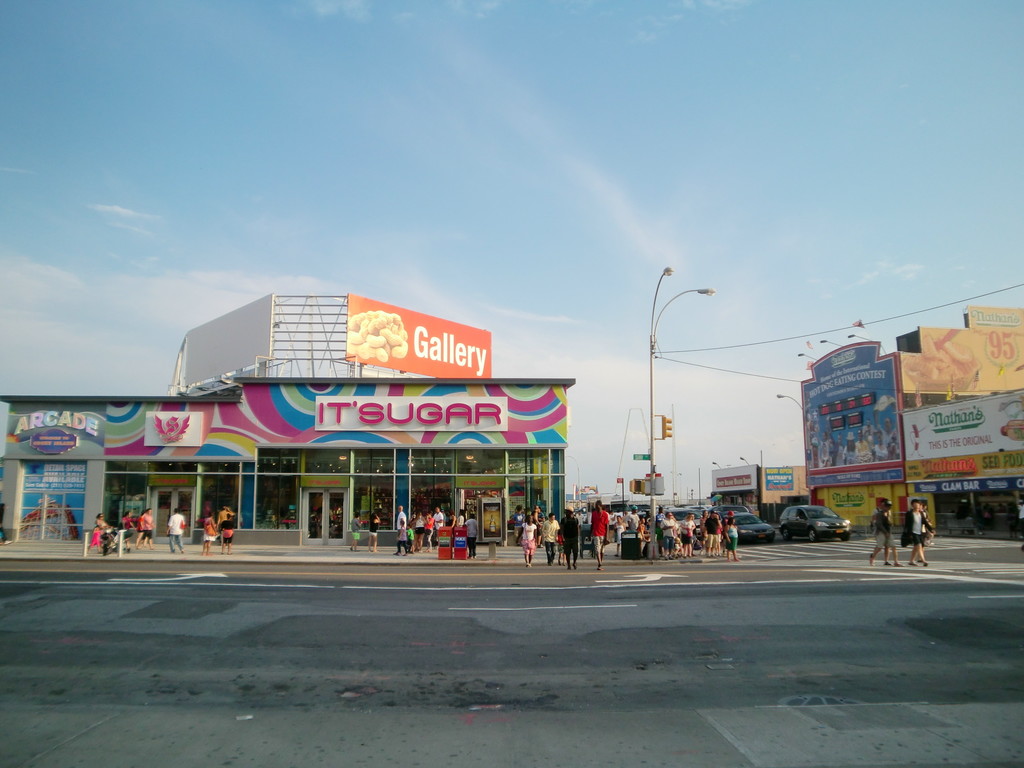
The establishment of the area now known as "Rabbit Island" by the European colonisers began in the middle of 17th century. Although the island and the part closest to the continental part were controlled by the Dutch, they chose not to establish themselves there and a patent, or a land title, was granted to a group of English settlers. They established the city of Gravesend in the continental part. The island was called "Coney Eylant" by the Dutch, possibly after the "rabbits" that lived there, although this affirmation is often disputed. When the English took possession of the Netherlands, the new governor returned to confirm the giving of the patent to the English settlers. Coney Island was used commonly used by the settlers as grazing lands for livestock and belonged to them essentially for the next 150 years.
As sea baths became more popular in the 18th century, few colonial aristocrats visited Gravesend Beach. The efforts to use Coney Island as a summer destination, however, didn't start until the 19th century. The construction of a private motorway toll-road through the stream that separates the island from the continent in the 1820s made it more accessible (and was no longer really an island). The supervisor of the city of Gravesend also built an inn providing food and accommodation, and promoted the tonic value of the sea baths. Soon, a second hotel was built on the island, and daily transport service from the continental part of Brooklyn was introduced. Daily ferry services to the island began in 1844.
It wasn't until after the Civil War, however, that Coney Island really began to flourish as a popular tourist destination. A group of hotels grew along the beach, often with restaurants and other facilities, including swimwear hire, for example. In 1868, a guide celebrated Coney Island as having the best beach on the Atlantic coast, and by 1873, it was attracting between 25, 000 and 30, 000 visitors every weekend.
Transport to the island began to thrive in the 1870s, when four steam railway lines were constructed to quickly transport passengers from Brooklyn to Coney. Two large docks were also built in this period, as well as an important public road.
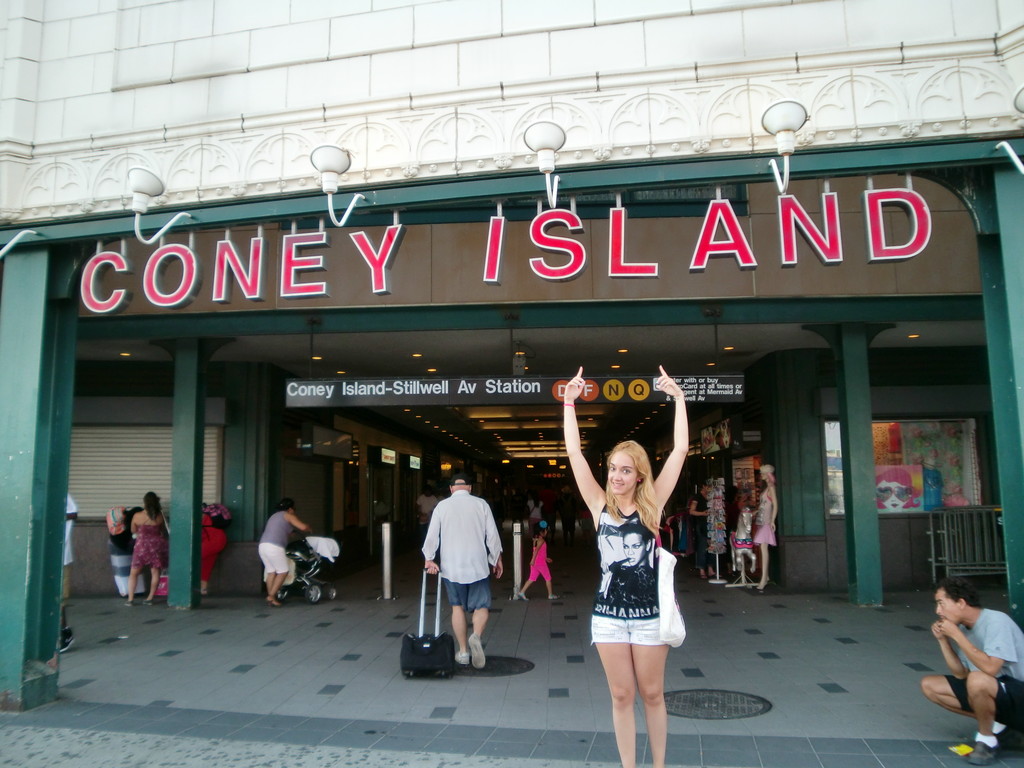
The opening of Coney Island also allowed for the introduction of a criminal element, and beginning around 1870, the section called "Gut" of Coney's West End became a centre for horse racing, boxing, gambling, drinking, and prostitution.
A vast amusement park also grew there. The first rollercoaster built in the United States, a Switchback, designed by LaMarcus Thompson, was inaugurated on Coney Island in 1884. It was a primitive step for early standards. Passengers had to board the train from an elevated platform 15 metres high, which was driven on a wooden track by gravity at a breakneck speed of six miles per hour (mph). The train came to a stop at the peak of a hill on the other side of the slope, where the passengers re-boarded the train (after they had changed from the opposite slope) for the return journey. The popularity of the rollercoaster encouraged the construction of other fairground attractions, amongst those, the first rollercoaster in the country that had a mechanical belt to lift the cars to its peak. Other attractions included: carousels, sleigh rides, and an aerial toboggan.
Besides from the mechanical entertainment, there were also:
- restaurants
- 10 cent museums
- concert halls
- dance pavillions
- supporting events
- circuses
- firework spectaculars
- gambling games
- an aquarium
- and, other fun events, which included:
- John Philip Sousa's marching band
- Buffalo Bill's Wild West Show
Many of these activities were part of the Bowery Midway, an area that had lots of games, spectacular events and attractions, like the streets of Cairo (Egypt), where you could ride an elephant or a camel, or see an erotic "Couchee-Couchee" dance by artists like the famous Little Egyptian.
The movement, from the 1880s, to grant workers a "vacation day" on Saturdays led to an increase in leisure time available to enjoy, which benefited the entertainment industry at Coney. It became increasingly easier and cheaper to arrive at Coney by train, and it offered a variety of cheap forms of entertainment, like nickel rides and hot dogs.
Working-class women, who had few places to go and socialise in, were just one of the groups that used Coney as an escape from their monotonous lives. Coney provided people with both an informal and fun atmosphere, which encouraged interaction between both sexes and recreational activities that were less structured and less regulated than those of normal social situations. This freedom is perhaps better reflected in the appeal of going to the beach with its, for the time being, scandulous beachwear.
Despite Coney's democratic spirit, which brought people of different social classes together, the universal segregation in American society was also seen there. Although Coney was often called the "Village Patio", not everyone was always allowed to enjoy themselves in the same places. The African-Americans had to use segregated public bathrooms and they were discouraged from occupying certain sections of the beach. Jews were also not welcome at some events in the first place.

Coney reached its peak at the end of the 19th century, with the construction of the spectacular amusement parks. The era began with the opening of the Sea Lion Park, the first enclosed park where an admission fee was charged at the entrance, in 1895. It only lasted until 1902, but it served as inspiration for the businessman and showman, George C. Tilyou, to create his even more elaborate Steeplechase Park.
One of the obstacles that businessmen like Tilyou faced was changing the continual perception thay Coney was an immoral area, infested with delicuents and crime. In line with the progressive reformers of the turn of the century, Tilyou searched to make an appeal to the middle class. Tilyou and the other founders of the enclosed park closed their parks to keep undesirables out, prohibited alcohol, and hired their own security personnel. The staple attraction for the company was a merry-go-round, where the participants rode a mechanical horse on a metal pole. Other attractions included: a Ferris wheel, a gondola ride along the Great Canals of Venice, a miniature train, a bath house, gardens, and a large dance hall. Half of the park burnt down in 1907, but Tilyou reconstructed it on an even bigger scale than it ever was.
Tilyou, the astute businessman that he was, learned that sex, at least if he provided it in quite safe, limited doses, would actually sell, even in the progressive era. Tilyou, in some way, mixed the "healthy fun" with that of the sensual kind, and the park was not seen, by the majority, as vulgar. To enter the park, for example, the visitors had to walk through the barrel of fun, a rolling barrel that threw them around. Popular attractions that also threw the people around included: human roulette, the hydromassage bath, and the human billiards table. Even more daring in that era was the so-called Blowhole Theatre, situated opposite the merry-go-round. As couples walked through a platform, air jets would force the women's skirts up, and the men often received an electric shock from a clown, whilst the previous victims were watching and laughing. In some way, the park's visitors were part of the entertainment; the shamed public lauging at themselves.
The spectacular Luna Park opened on 16 May 1903. Nicknamed the "Electric Eden", Luna Park was a fantasy land illuminated by some 250, 000 electric lights; in fact, Coney's laughs, not those of the Statue of Liberty and the New York skyline, were the first thing that people who arrived at the port of New York could see. The park included attractions like:
- a "Trip to the Moon"
- another illusion called "Twenty Thousand Leagues Under the Sea"
- a circus
- theatre shows and spectaculars based on various historical disasters, like the Fall of Pompeii and Galveston, Texas
- elephant and camel rides
- a 70 metre tall tower with colour-changing lights
- replicas of many cultures, including Japan, Ireland and Italy
Luna Park, which was based on carefully constructed illusions and audience manipulation, tended to attracted the somewhat richer members of the public.
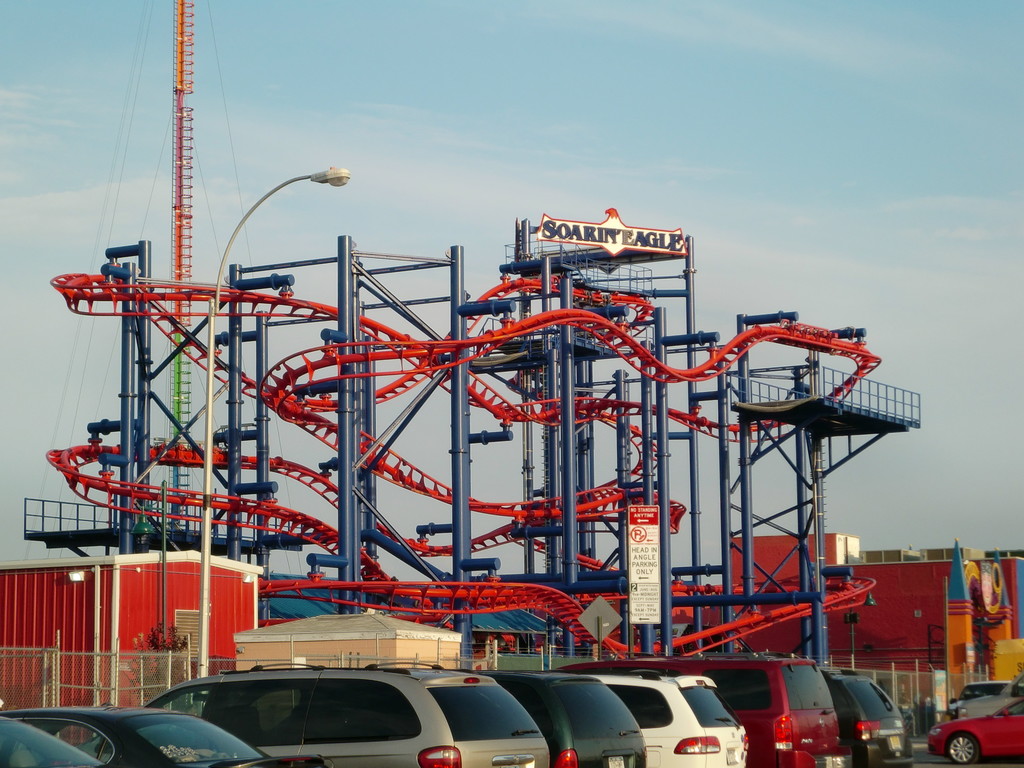
The last of the "big three" amusement parks on Coney Island was Dreamland. The park opened its doors in 1904, and was designed to be an even bigger, and more sophisticated, version of Luna Park. The many attractions at Dreamland included:
- a city inhabited by dwarfs
- Frank Bostock's wild animal spectacular
- scenic railways
- a dance hall
- a Japanese tea garden
- a boat journey to the 'Gates of Hell'
- and, a display of baby incubators (a spectacular which showed that the lives of triplets had really been saved
As magnificent as the park was, however, it was not a financial success. Maybe the efforts of the owners to provide a more refined kind of entertainment was not taken on by the majority of the visitors to Coney. Dreamland soon became bankrupt and was sold off in an auction in 1910. It never had another opportunity to be successful as a fire destroyed a large part of the park in 1911.
Coney was at its peak during the years that its three main amusement parks dominated the scene. It was the main tourist destination in America. It routinely brought 100, 000 visitors. On the other hand, Disney World has never reached this figure.
As John Kasson has argued, Coney, in this period, reflects important changes in American society, with the appearance of a new culture of the masses, one that opposes the most distinguished rules about tastes and behaviours of the Victorian era. The activities available at Coney, like swimming, dance, variety shows and circus acts, mechanical rides and exotic attractions, were all part of this new cultural state of mind. It was becoming a symbol of fun and partying, and also of important changes in American traditions and morals.
Although Coney Island still remains to be an important amusement park, with its beach often attracting hundreds of thousands of visitors daily throughout the 1950s, at least, it has never recovered the glory it basked in during its 'golden years'.
Photo gallery
Content available in other languages
- Español: Coney Island
- Italiano: Coney Island
Rate and comment about this place!
Do you know Coney Island? Share your opinion about this place.


































